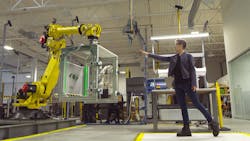Making Industrial Robots Collaborative
Collaborative robots, or cobots, have helped generate a resurgence in industry’s interest in robotics. This is occurring in response to the difficulties that industry faces in attracting and retaining skilled workers and improving worker safety and ergonomics.
Despite the headway cobots have made in industry, their design relegates them to mimicking simple, repetitive tasks typically done by humans. The high-speed heavy lifting done by industrial robots remains outside the scope of most cobot designs. Increasingly, technology companies are devising ways to make industrial robots more collaborative.
At the Smart Production Systems conference in Nuremberg last fall, I reported on work being done by Mitsubishi and Real Time Robotics to bring collaborative capabilities to industrial robots. More recently, I had a chance to meet with Clara Vu, co-founder and CTO of Veo Robotics, and Patrick Sobalvarro, Veo's president, CEO and co-founder, at the Tech Crunch Robotics + AI conference in Berkeley, Calif.
The cages around industrial robots are not made to keep robots in, said Vu, but to keep people from getting hurt. “You want robots that can lift heavy payloads, move them quickly and place the payloads precisely. That’s why we’re focusing on a sensing and vision system that provides safety for industrial robots,” she said.
Vu added that Veo’s approach with FreeMove applies to not just to workcell safety, but can also be extended for application throughout a line or an entire factory.
Explaining FreeMove’s technology, Vu noted that manufacturers commonly uses computer vision, like that found in the FreeMove system, for inspection, but she added “We use different algorithms. We do a 3D reconstruction of the space that includes occupancy and occlusion analysis using deterministic algorithms, rather than machine learning, so that we can see into any space in the environment that we can’t prove is empty so that safety certification can be achieved.”
Beyond the pure technology aspects of Veo’s FreeMove, Vu said an important part of the company’s approach is to have their system perform in a way that will train the humans working with it. “FreeMove controls industrial robots so that the robot arm slows and stops in a very predictable way,” Vu said. “Humans are good at reacting to that and optimizing around that. We also show the robot’s internal state to workers so they can understand that. This is the best way to create functional interaction.”
She explained that the FreeMove system features a monitor that shows users the view as the “system sees it—what it can and can’t see, and even a robot future cloud [where the robot’s arm could extend to] shown in a 3D visualization. This is not required for system to run but it’s there for users to see.”
Sobalvarro noted Veo currently has relationships with ABB, Fanuc, KUKA, and Yaskawa and that the system is currently in use at aerospace, automotive, household appliance, and construction equipment manufacturing sites. None of Veo’s current end users are allowing the company to divulge their names yet, which is understandable for a startup company, but Vu noted that the ARM [Advanced Robotics for Manufacturing] Institute, a government funded consortium, has made its use of FreeMove public.
To date, Veo has received $28 million in funding ranging from companies such as Siemens-backed Next47 (which invested because of Veo’s focus on safety through its work with international standards organizations), to Silicon Valley investors Google Ventures and Lux Capital, to Baidu Ventures.
Despite the advances being made by automation to perform tasks formerly done by humans, Vu believes manufacturing will likely always need humans because of their flexibility. “The future of manufacturing will be humans doing what humans do best and robots doing what robots do best.” She believes the current general view of artificial intelligence—i.e., that robots can potentially replace humans—is holding robots back because that leads researchers to try to get robots to do what humans do. “Let robots be robots,” she said. “There’s a huge amount of value to be unlocked here.”
About the Author
David Greenfield, editor in chief
Editor in Chief

Leaders relevant to this article:



